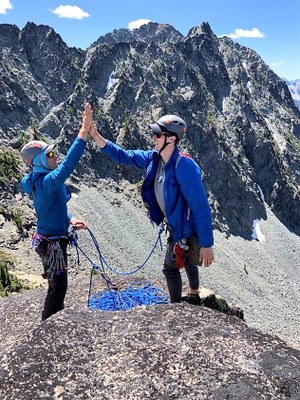
Trip Report
Basic Rock Climb - The Fin/Northwest Ridge
The Fin is an excellent Basic Rock Climb, comprised of 3 full 60m pitches of stellar ridge climbing in the gorgeous Washington Pass area. I recommend this climb as a less busy alternative to SEWS and Kangaroo Temple.
- Thu, Jul 25, 2019
- Basic Rock Climb - The Fin/Northwest Ridge
- The Fin/Northwest Ridge
- Climbing
- Successful
-

- Road suitable for all vehicles
-
We ascended the climber's trail to Kangaroo Temple from the hairpin turn on highway 20. From below Kangaroo Temple we continued to traverse high along the ridge, trying not to lose elevation except where we encountered large granite slabs, which we traversed below. We encountered a large boulder field at the gully between Tomohawk and the Fin, which we ascended via a path of least resistance. Generally we encountered less bushwhacking and loose terrain than we expected. The approach is completely snow free. There is no water after the small pond below Kangaroo Pass.
We completed the route in 3 rope stretching pitches. The rock quality was higher than expected. The scramble descent was easy to follow, and we were able to reach our packs via a climber's path that hugged the Fin's south face.
Car-to-car time was under 12 hours, slowed down slightly by a manageable medical condition on the descent.
I am writing this trip report from the perspective of a six person basic climb with three students who had never been on a Mountaineers alpine rock climb before. Hopefully I have included enough details to encourage climb leaders to post this climb as an alternative to the busier Kangaroo Temple and South Early Winters Spire. It deserves to be more popular than it is.
We left the hairpin turn on highway 20 at 6 AM, following the climber's path to Kangaroo Temple. Where the trail continues upward to the base of KT, we continued traversing high along the ridge toward Tomahawk. There are various slabs along the way that require some descent, but generally we found that staying high led to the least amount of bushwhacking on fairly secure terrain. Eventually we came to a boulder field that marks the gully between Tomahawk and the Fin.
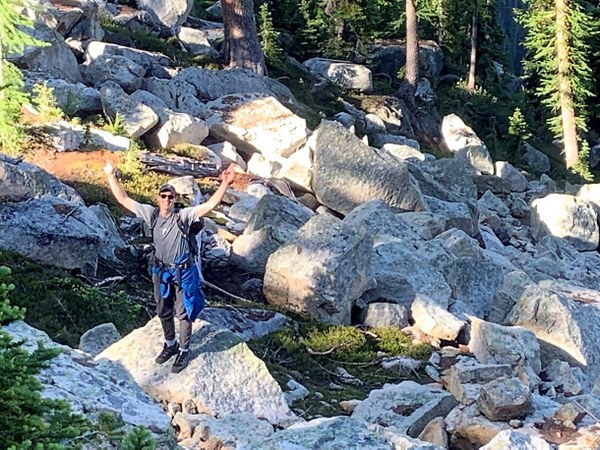 The gully between Tomahawk and the Fin was not snow covered, so we were happy with our decision to leave our crampons and ice axes at Kangaroo Pass (That is, until the end of the day when we departed the pass without retrieving them and Mike, James, and Ben were kind enough to go back up the pass to get them). While there was some loose rock and scree in the gully, it was not too steep; there was even some semblance of a boot path at times.
The gully between Tomahawk and the Fin was not snow covered, so we were happy with our decision to leave our crampons and ice axes at Kangaroo Pass (That is, until the end of the day when we departed the pass without retrieving them and Mike, James, and Ben were kind enough to go back up the pass to get them). While there was some loose rock and scree in the gully, it was not too steep; there was even some semblance of a boot path at times.
We made it to the notch between Tomahawk and the Fin at around 10 AM, 4 hours after we started. There was some uncertainty as to where the climb began. In the end, we chose a route that had the least amount of lichen on it, appeared to not have much loose rock, and had some visible cracks to set pro in. It was on the southwest side of the peak, along an obvious climber's path that circles the peak toward the scramble route. The first pitch generally went straight up to gain the ridge. Just on the other side of the ridge I found a tree with old rap slings on it, confirming we were on something that someone had climbed before. I found a large live tree to belay my follower up. The first pitch was probably 45 meters. I don't think that this was the easiest way up, as some moves felt like 5.5-5.6 climbing, but generally the rock was more solid than I expected from the small amount of beta we had prior to the climb. It had some pretty fun climbing moves on it. I also think that other trip reports split this pitch into 2-3 pitches, but I don't really see why you'd do that since it's less than a rope length, not wandery, and communication is fine between belayer and follower.
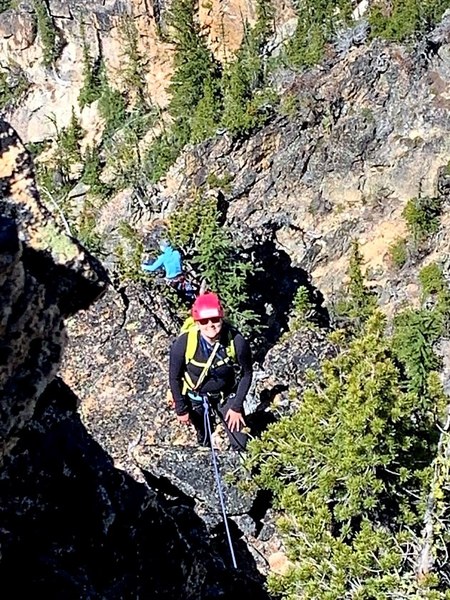 Pitch 2 is a long, traversing fourth class ridge. It would be difficult to truly protect the follower from a pendulum here, so I recommend using judgment and trying to get gear in after any particularly tricky moves. I used most of a rope length here, again finding a nice large tree to belay from. The other two rope teams set up a belay slightly further ahead on the route than I did, which came in handy for them later on the climb. At this point, all I could see was a 30' high point in front of me. I thought it might be the summit but it turned out to just be a high point along the ridge.
Pitch 2 is a long, traversing fourth class ridge. It would be difficult to truly protect the follower from a pendulum here, so I recommend using judgment and trying to get gear in after any particularly tricky moves. I used most of a rope length here, again finding a nice large tree to belay from. The other two rope teams set up a belay slightly further ahead on the route than I did, which came in handy for them later on the climb. At this point, all I could see was a 30' high point in front of me. I thought it might be the summit but it turned out to just be a high point along the ridge.
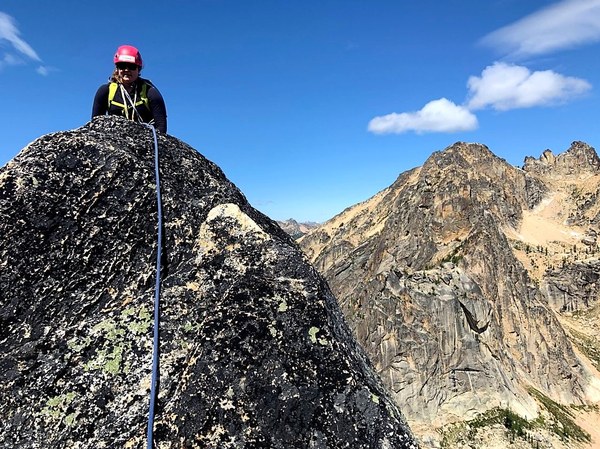 The third pitch was a lot of second and third class ridge walking punctuated by a couple of climbing moves. Notable ones included a 20' section of slab where you actually have to use your hands for balance and an 8' section of finger crack in a dihedral to gain the summit block. Someone placed two rocks below the crack as an assist, which I thought were funny but unnecessary. If you don't enjoy the finger crack you can also just climb up and over some slab to the summit, which is what my follower and I did (I unfortunately didn't see the finger crack until I was passed it).
The third pitch was a lot of second and third class ridge walking punctuated by a couple of climbing moves. Notable ones included a 20' section of slab where you actually have to use your hands for balance and an 8' section of finger crack in a dihedral to gain the summit block. Someone placed two rocks below the crack as an assist, which I thought were funny but unnecessary. If you don't enjoy the finger crack you can also just climb up and over some slab to the summit, which is what my follower and I did (I unfortunately didn't see the finger crack until I was passed it).
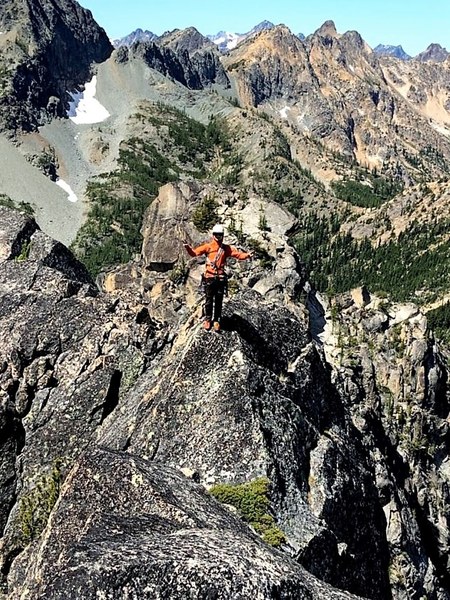 I didn't quite get to the summit before I ran out of rope on the third pitch, so I build a quick anchor and brought my follower up for the final 15'. We were not able to communicate at this point, so radios would have been helpful. The other two rope teams, having belayed from a different location at the end of pitch two, were able to reach the summit on the third pitch. Ample cracks exist on the summit to build a gear anchor of choice.
I didn't quite get to the summit before I ran out of rope on the third pitch, so I build a quick anchor and brought my follower up for the final 15'. We were not able to communicate at this point, so radios would have been helpful. The other two rope teams, having belayed from a different location at the end of pitch two, were able to reach the summit on the third pitch. Ample cracks exist on the summit to build a gear anchor of choice.
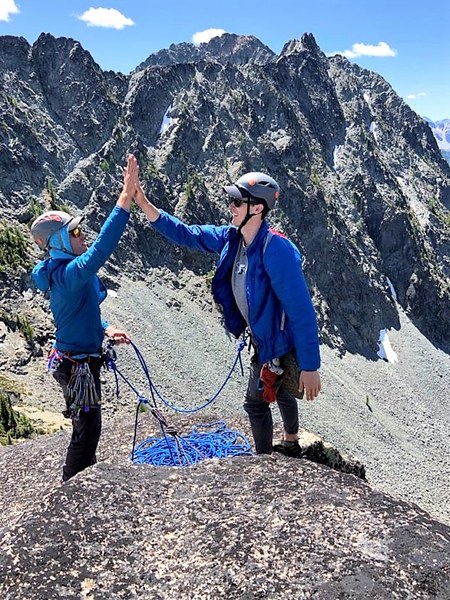 The final team reached the summit by noon and we spent probably an hour lounging in the sun. The summit is large and slabby with plenty of room to walk around unroped, nap, and eat.
The final team reached the summit by noon and we spent probably an hour lounging in the sun. The summit is large and slabby with plenty of room to walk around unroped, nap, and eat.
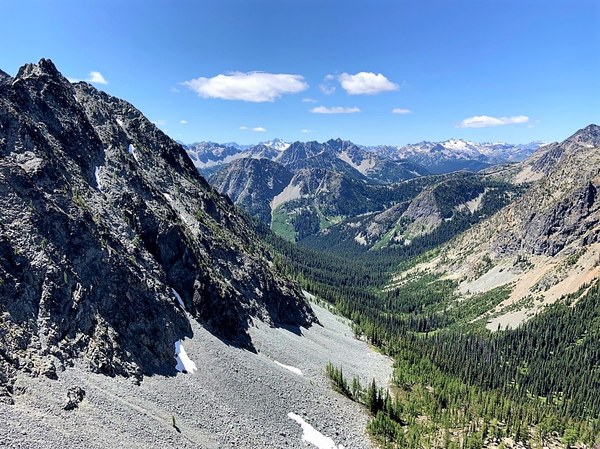 We descended via the scramble route. It is fairly obvious if you follow the post polished rock on ledges in an easterly direction from the northern part of the summit. The ledges are probably class 3. Then descend into a loose gully for about 200', traversing back toward the Fin/Tomahawk notch. We were able to traverse and pick up a climber's path that hugs the base of the Fin without losing any elevation to get back to our packs at the notch.
We descended via the scramble route. It is fairly obvious if you follow the post polished rock on ledges in an easterly direction from the northern part of the summit. The ledges are probably class 3. Then descend into a loose gully for about 200', traversing back toward the Fin/Tomahawk notch. We were able to traverse and pick up a climber's path that hugs the base of the Fin without losing any elevation to get back to our packs at the notch.
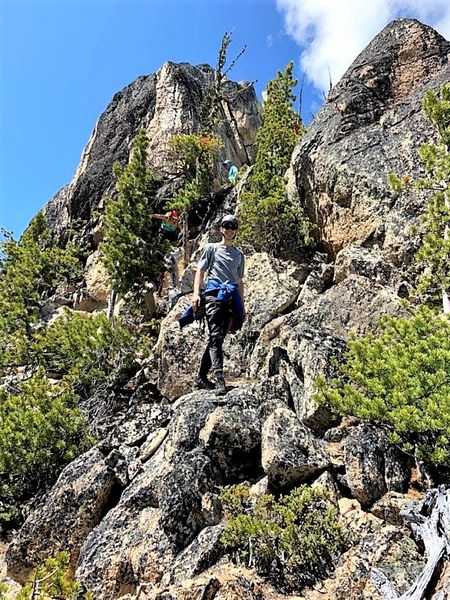 It was 1:45 PM when we reached our packs. We stayed as high as we could as we traversed back to Kangaroo Temple, eventually picking up the climber's path. From there it was a straightforward descent to the cars, which we reached at 5:20 PM. We did have a minor medical issue; a student complained of stomach pain, nausea, and was feeling faint. We stopped more frequently than we would have otherwise to monitor and address the pain. In the end, they drank a lot of water, ate food, and had some of their pack contents disbursed amongst other team members, which seemed to resolve the issue... they ended up being one of the first team members back to the car! It was a very hot day; a reminder to be constantly eating and drinking when dealing with a full day of heat and exposure.
It was 1:45 PM when we reached our packs. We stayed as high as we could as we traversed back to Kangaroo Temple, eventually picking up the climber's path. From there it was a straightforward descent to the cars, which we reached at 5:20 PM. We did have a minor medical issue; a student complained of stomach pain, nausea, and was feeling faint. We stopped more frequently than we would have otherwise to monitor and address the pain. In the end, they drank a lot of water, ate food, and had some of their pack contents disbursed amongst other team members, which seemed to resolve the issue... they ended up being one of the first team members back to the car! It was a very hot day; a reminder to be constantly eating and drinking when dealing with a full day of heat and exposure.
Again, I really enjoyed this climb relative to other basic rock climbs. It was three rope stretching pitches with a climbing level difficulty similar to Kangaroo Temple. I think that the views along the ridge were better than SEWS and KT. The hike in is slightly less straightforward and longer than some, but it is offset by not needing to rappel the route. I hope that this trip report encourages other people to check out this climb if SEWS and KT or taken, or if they simply want to do something different.
A few caveats:
- Gear placements are more sparse on this climb than the typical basic climb. Rope leaders should have a good sense of when to protect climbing moves versus letting the scramble terrain be unprotected for their followers.
- We had three students who had never been on a Mountaineers rock climb before, a first year intermediate student, and a mentored leader on this climb. All did a fantastic job and the route did not seem to be beyond anyone's risk tolerance or skill level. However, a more timid intermediate rope lead may not have enjoyed the lack of protection that was available. I would say that having competent rope leads is almost more important than having experienced basic students on this climb.
- A single rack of BD .3-3 cams and half set of stoppers with 4 double and 4 single runners was more than sufficient.
- We lost communication on the third pitch, so radios would have been helpful.
 Sherrie Trecker
Sherrie Trecker